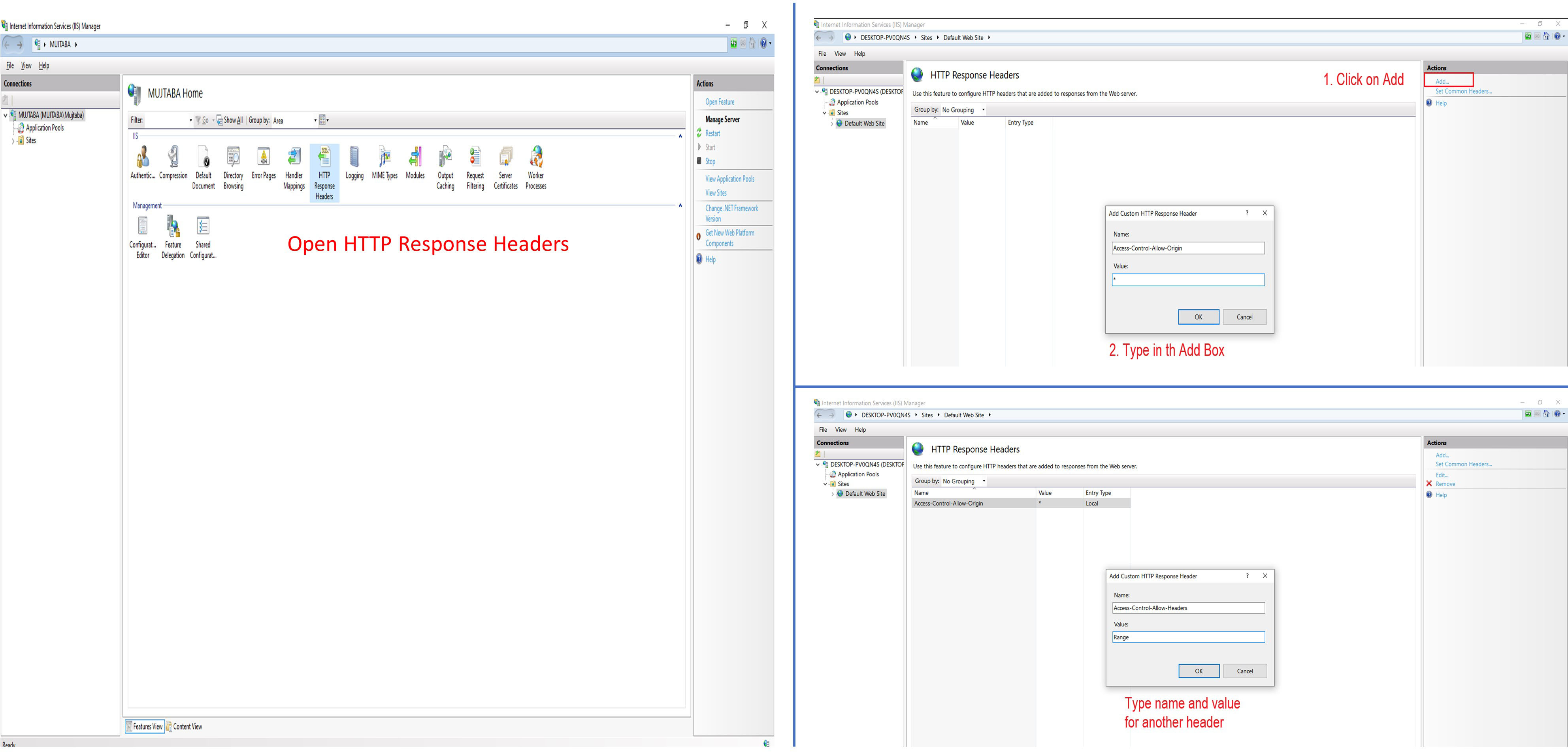Configure DASH Server on Windows 10/11
Dynamic Adaptive Streaming over HTTP (DASH), or MPEG-DASH, is an adaptive bitrate streaming technique. It enables high-quality streaming of media content over the Internet delivered from conventional HTTP web servers. Like Apple’s HTTP Live Streaming (HLS) solution, MPEG-DASH breaks the content into small segments served over HTTP. Each segment contains a short interval of playback time of content that is potentially many hours, such as a movie or the live broadcast of a sports event. The content is made available at a variety of different bit rates, i.e., alternative segments encoded at various bit rates covering aligned short intervals of playback time REF. Now, we will move forward towards the steps followed in the process:
Step 1: Creation of the Web Server
Microsoft provides Internet Information Services (IIS) that can be easily used as a web server. To configure, follow the straightforward steps below:
- Select and open Windows features (WindowsKey+S (Search box), then type Turn Windows features on or off).
- Find Internet Information Services and tick the box (wait for the process to configure and then Close).
- Test it by opening Chrome and navigating to your local internet address, 127.0.0.1.
- The default page should appear (if not, reboot your system).

Step 2: Change Default Physical Path
You can skip this step if you don’t want to change the default path. All the files can be located at the default path C:\inetpub\wwwroot\.
- Open IIS Manager (WindowsKey+S, then type IIS).
- The Default Site stores its files in a particular directory. To expose this information, right-click on it, choose Manage Website, then Advanced Settings.
- This will open a pop-up window with all of the default site information, such as files or document roots, as they are typically known, enabled protocols, and even bindings.
- If you click on Physical Path, a button appears on its extreme right where you can choose a different document root. This is the location where your web server will look for files to serve to clients. It’s important to set this correctly to ensure your server functions as expected.

Step 3: Enabling Cross-Origin Resource Sharing (CORS)
To test streams, you need to allow other websites to access files on your web server. This practical task is done by enabling cross-origin resource sharing (CORS). Follow these practical steps:
- Open the webserver (WindowsKey+S then type IIS).
- Select Default Web Site and right-click or double-click HTTP Response Headers.
- Select Open Feature from the Action pane. Then, click Add and type in Access-Control-Allow-Origin for Name and type “*” for Value.
- Click OK to add the header. To add another value, type in Access-Control-Allow-Headers for Name and type Range for Value.

Step 4: Adding the DASH MIME Type
DASH requires statements to learn how to analyze video and audio files. DASH manifest files end in .mpd. Windows IIS does not know about this extension by default. Follow these steps to add the MIME type:
- Under connections, click your server and double-click MIME Types.
- Type .mpd for File name extension and type application/dash+xml for MIME-type. Press OK.
- Type .m4s for File name extension and type video/mp4 for MIME-type. Press OK.

Step 5: FFmpeg Installation
- Download FFmpeg from the readily available source here.
- Extract the downloaded FFmpeg zip file to C:\ffmpeg.
- Navigate to the bin folder under C:\ffmpeg and copy the address using Ctrl+C.
- Open up the System information window and click on Advanced System Settings. Then click on Environment Variables.
- Select the Path variable under System variables.
- Click Edit and then click New.
- Type Ctrl+V to paste in the address where you extracted FFmpeg earlier. Then press OK.
Check Installation
Open cmd and type ffmpeg in the command prompt. If you see much text in the cmd, your FFmpeg is installed successfully.
Step 6: Prepare Workspace
- Download the sample video BigBuckBunny.
- Rename the downloaded file to input.mp4.
- Run the following command in the cmd in the same directory:
ffmpeg -re -i input.mp4 -map 0 -map 0 -c:a copy -c:v libx264 -b:v:0 800k -b:v:1 300k -s:v:1 320x170 -profile:v:1 baseline -profile:v:0 main -bf 1 -keyint_min 120 -g 120 -sc_threshold 0 -b_strategy 0 -ar:a:1 22050 -use_timeline 1 -use_template 1 -window_size 5 -adaptation_sets "id=0,streams=v id=1,streams=a" -f dash out.mpd
- Once the process is completed, copy all the files excluding input.mp4 into the default IIS physical path (i.e C:\inetpub\wwwroot\) or the modified path.
To generate segments from multiple videos, clone the repository using the following command:
git clone https://github.com/iamgmujtaba/dash-server.git
Then run the following script:
python .\main.py -i .\input\ -o .\output\
Step 7: Final Testing
Check your IP Address
Open cmd and type ipconfig. Get IPv4 Address. It would be 192.XXX.XXX.XXX.
Play Video on DASH Player
VLC
- Install VLC.
- Open Network Stream by using Ctrl+N.
- Type the URL like this http://192.XXX.XXX.XXX/bbb_dash/out.mpd. bbb_dash is the directory of the processed BigBuckBunny video and out.mpd is the DASH text file we created using the above script.
- Finally, press play.
If you can watch the video, it means you have successfully configured DASH on your Windows machine.
Ubuntu or Jetson Devices
Suppose you want to utilize a native DASH web player. In that case, you can clone dash.js from GitHub and then follow the installation instructions.
The main code is available at GitHub.
Raise an issue if you are facing any problems.
Enjoy Reading This Article?
Here are some more articles you might like to read next: